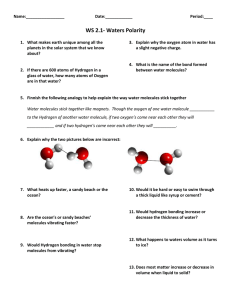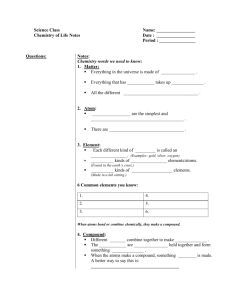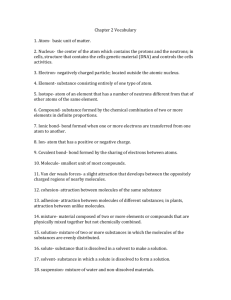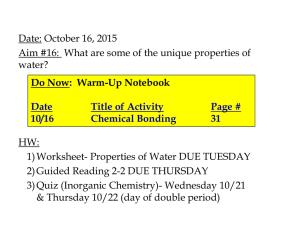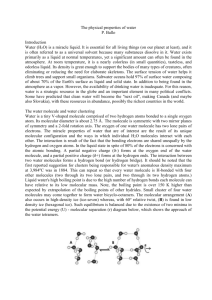Earth formation and water properties
advertisement
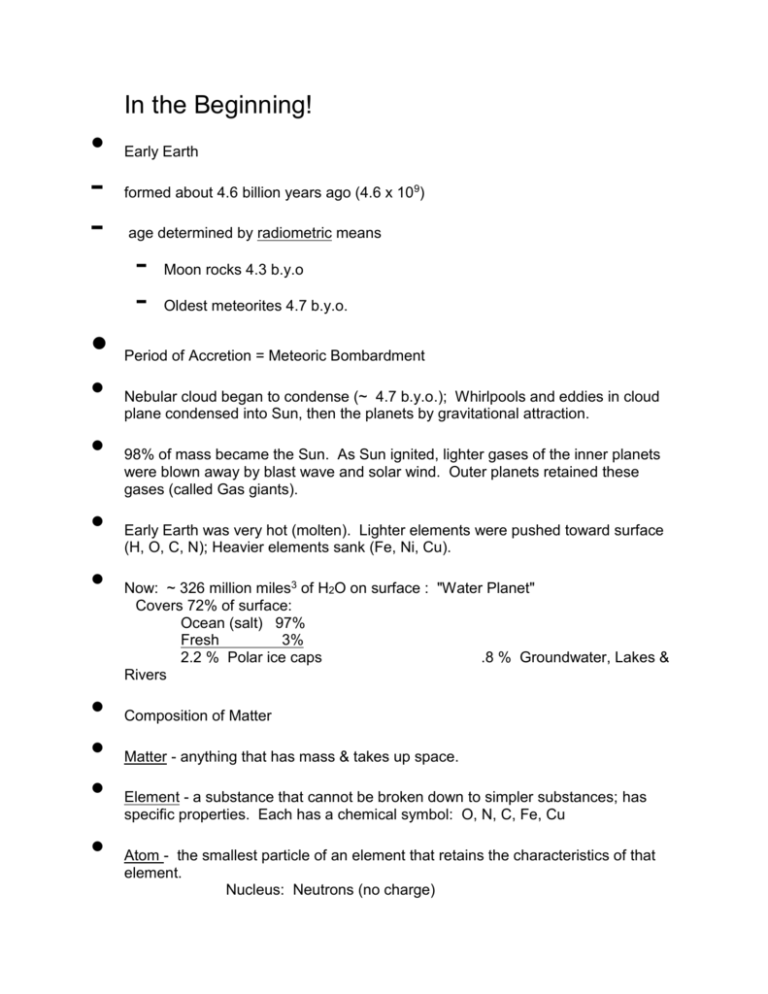
In the Beginning! • - • • • • • • • • • Early Earth formed about 4.6 billion years ago (4.6 x 109) age determined by radiometric means - Moon rocks 4.3 b.y.o Oldest meteorites 4.7 b.y.o. Period of Accretion = Meteoric Bombardment Nebular cloud began to condense (~ 4.7 b.y.o.); Whirlpools and eddies in cloud plane condensed into Sun, then the planets by gravitational attraction. 98% of mass became the Sun. As Sun ignited, lighter gases of the inner planets were blown away by blast wave and solar wind. Outer planets retained these gases (called Gas giants). Early Earth was very hot (molten). Lighter elements were pushed toward surface (H, O, C, N); Heavier elements sank (Fe, Ni, Cu). Now: ~ 326 million miles3 of H2O on surface : "Water Planet" Covers 72% of surface: Ocean (salt) 97% Fresh 3% 2.2 % Polar ice caps .8 % Groundwater, Lakes & Rivers Composition of Matter Matter - anything that has mass & takes up space. Element - a substance that cannot be broken down to simpler substances; has specific properties. Each has a chemical symbol: O, N, C, Fe, Cu Atom - the smallest particle of an element that retains the characteristics of that element. Nucleus: Neutrons (no charge) Protons (+ charge) Electron: move in regions outside nucleus (- charge) • The number of electrons and protons should be equal in each element. • • Compound - made up of molecules Molecule - the smallest unit of a compound that retains the characteristics of that compound. • • • Water The most common compound on Earth's surface Extremely important to Biological systems; Life could not exist without it. Makes up 55 - 96% of living things; Adult human: 65 - 72% Baby: 75% Steer: 55% Jellyfish: 96% Carrot: 88% Watermelon: 93% • Molecule: H2O - chemical formula -two hydrogen atoms covalently bonded to one oxygen atom in a 2:1 ratio. Covalent bond - the sharing of electrons between two atoms. A very strong chemical bond! O H oxygen atom • + H H O H 2 hydrogen atoms = water Unique Properties of Water • Water is a Polar molecule with opposite charges on each end. • Dissolving power - called the "Universal Solvent“ • • • • Cohesion - attraction of "like" molecules. Caused by Hydrogen bonding - unlike charges of the water molecule attract Hydrogen bonding - the positive region of one molecule attracts the negative region of another. Not a true chemical bond! It is a weak attraction water molecules have for each other; allows water to be a liquid at room temperature; produces cohesion and high surface tension. Adhesion - Positive and negative ends can attract other surfaces; called the "wetting capacity;" due to polarity. High Heat of Vaporization - water has a large capacity for absorbing heat. Many hydrogen bonds must be broken for water to vaporize or evaporate. • Resistance to Temperature Change - Hydrogen bonds absorb heat when they break and release heat when they form. Ex: water droplets on cold glass (formation) evaporative air conditioners; sweating (break) • Lower Density of Ice - water molecules form an hexagonal matrix when it freezes due to hydrogen bonding. Takes up more space, therefore is less dense, so it floats. Prevents lakes and streams from freezing solid; protects life forms during winter. Put these notes at bottom of page 4 Question: Why can water dissolve so many things? Answer - Its Polarity ! Ex: NaCl (common table salt, sodium chloride) Sodium and chlorine attract one another because they they have opposite charges Na+ClWhen this salt dissolves in water, the sodium and chlorine atoms separate to form ions. The positive Na+ is surrounded by the negative ends of the water molecules.

